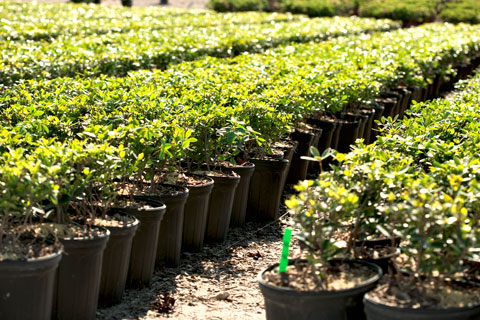8/1/2023
5 Herbicide Myths Holding Your Program Back
Broch Martindale

For any nursery crop, weed control is essential to producing beautiful, vibrant plants. For the continued growth of the green industry, it’s important that these management programs are both environmentally responsible and cost-effective.
Weed management strategies commonly rely on multiple applications of pre-emergent and post-emergent herbicides that are supplemented with hand-weeding. To help you build a robust program, it’s important to dispel some myths about using herbicides in your production.
Myth 1: Herbicides aren’t safe for herbaceous perennials.
When it comes to weeds, “start clean and stay clean” should be the motto, especially for producers of herbaceous perennials. Many growers feel herbicides that are safe to use on herbaceous perennials either are too scarce, control too few weeds, or control a lot of weeds, but are only safe on a few ornamentals. There are herbicides available that are safe on herbaceous perennials and control many weeds while being safe to use on a variety of ornamentals.
For instance, Gallery specialty herbicide offers exceptional control of broadleaf weeds, all while being one of the safest sprayable formulations. Gallery provides season-long control of more than 90 broadleaf weeds and can be applied on or around more than 700 ornamentals.
Looking for another option? Granular formulations are much safer for a larger number of crops than sprayable formulations. However, cost and time advantages should be considered. If you’re leaning toward a granular, products such as Snapshot specialty herbicide and Fortress herbicide by OHP offer the widest crop protection and flexibility for your program. Investing in these products will provide peace of mind when it comes to plant safety and can reduce labor inputs for your facility.
To manage weeds effectively, a robust nursery weed management program should include pre-emergent and post-emergent herbicides, as well as sanitation and hand-weeding. (Always read and follow label directions.)
Myth 2: There’s no way to prevent weed infestation.
Preventing weed spread is a crucial component of a weed management program for perennial producers. Weed seed can be introduced into nurseries in the potting media, by wind-blown seed, splashed into pots by rain, deposited by birds and in existing production. Here are a few ways you can prevent a weed infestation through sanitation:
• Inspect potting substrate sources for weeds.
• Inspect new shipments of liners before potting. If you observe weeds, you have two choices: 1) Refuse the shipment; or 2) remove the top half inch of potting media from the liners and dispose of that contaminated media.
• Weed infestations build over time! Hand-weed frequently to keep weeds from going to seed.
• After hand-weeding, remove the weeds and dispose of them properly. Don’t let them sit around to dry and drop seed.
• Recycled potting media tends to be loaded with weeds. Do not use recycled substrates in herbaceous perennial production.
Myth 3: Equipment calibration is not necessary before applying product.
Calibration is a crucial step when using any product. A lot of times when products aren’t working, it’s due to a lack of proper equipment calibration. In some cases, after careful examination, we find calibration is often the leading cause of a product not being as effective. The most expensive application is the one done at the wrong rate.
Myth 4: Mulches can solely replace herbicide applications.
Many container-grown nurseries now use mulches for weed control for “herbicide-sensitive” crops. It’s true that mulches can control most common nursery weeds, but be cautious with mulches in herbaceous perennial production. It’s recommended to pair mulching with pre-emergence herbicides for more robust weed control.
Mulches control weeds by removing the light from the seed and newly germinated seedlings. Mulches can hold excessive moisture at the crown of the plant, which can lead to crown or root rot. For crops that are susceptible to crown rot, it’s best to avoid the use of mulches.
However, crops with high-moisture demands may grow better with mulches. If mulches are used, the grower should monitor soil moisture conditions and adjust irrigation schedules accordingly. Adequate depth on the media surface is necessary for success in using mulches.
Myth 5: Herbicides wear off and don’t offer continued control.
Overwintered crops often have the biggest risk of becoming infested with weeds. Standard practice is to hand-weed these plants after overwintering, but this usually pulls you away from other important spring tasks.
To avoid weed problems in overwintered crops, apply a pre-emergent herbicide, such as Gallery or Snapshot specialty herbicides, several weeks before covering the crop ahead of winter. If applying later in the season, both Gallery and Snapshot have a place in your program because one is a liquid sprayable and the other is a granular. Both products work around the clock to keep ornamentals weed-free, preventing hand-weeding and the need for re-treatment. Be sure to check the label for specific recommendations. Protecting overwintered material is crucial to starting out the season right.
Identifying the weeds you have and selecting herbicides that are safe and effective will go a long way toward your success. Supplement herbicide applications with both manual and cultural controls to prevent and manage weeds in your facility, which will also help mitigate pests and diseases in your facility.
When it comes to weed control, you have options. Weed control in perennial production depends upon an integrated weed management program that includes sanitation, herbicides and hand-weeding. Although herbicides can cost more upfront, the investment can help reduce time and money spent on hand-weeding, giving you more time to focus on other areas of your business. GT
Broch Martindale is the National Nursery & Greenhouse Strategic Account Manager with Corteva Agriscience.